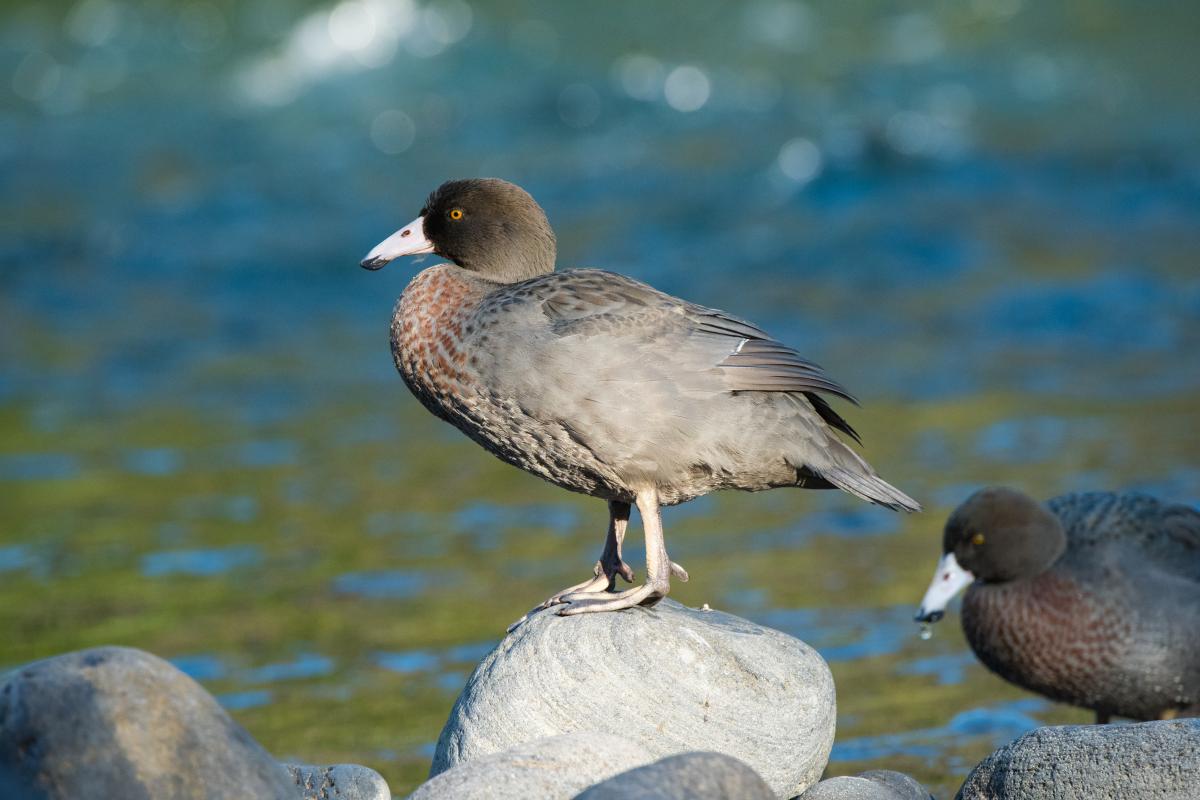
Something BIG is Stirring
We Need Your Support to Rewild Aotearoa

Learn about our iconic blue duck/whio, that’s only found in New Zealand and faces a risk of becoming extinct
Population: Under 3,000
New Zealand status: Endemic
Conservation status: Threatened–Nationally Vulnerable
Found in: Clean, fast-flowing rivers in the North and South Islands
Threats: Habitat loss, predation, disturbance
Sound recording:
Blue duck/whio song (MP3, 1,342K)
01:24 – Adult pair in a stream communicating and answering tape recorded calls.
Our bird songs can be reused, even commercially, according to our copyright terms.
Species information: Whio on NZ Birds Online
Blue Duck/Whio Conservation
In the rushing currents of New Zealand’s pristine rivers, an ancient species keeps a watchful eye – the whio, or blue duck. With their distinctive slate-blue plumage and haunting calls, these remarkable waterfowl are more than just a natural treasure; they are sentinels of the nation’s ecological health.
A Taonga of Aotearoa
For the Māori people, the whio holds a special place as a taonga (treasured) species, with a strong cultural, spiritual, and historical connection. Their name, whio in the North Island or ko whio whio in the South, echoes the distinctive call of the male bird, forever watchful and ready to sound the alarm at the slightest disturbance.
Believed to be an ancient species that emerged early in evolutionary history, the whio’s isolation in New Zealand has resulted in unique anatomical and behavioral adaptations. Their iconic status is further cemented by their appearance on the nation’s $10 banknote, a testament to their significance as a symbol of the country’s natural heritage.
River Specialists
The whio is one of the few waterfowl worldwide that lives year-round on fast-flowing rivers, making them true river specialists. Their presence is a key indicator of healthy waterways, as they require clean, swift streams in forested upper catchments with high water quality, low sediment loads, stable banks, overhead canopy cover, and diverse invertebrate communities.
Their fight for survival, however, is an uphill battle. Once widespread throughout New Zealand, whio populations are now patchy and isolated, with an estimated 640 pairs in the North Island and just under 700 pairs in the South Island – a total population between 2,000 and 3,000 individuals, and declining.
Adapted to a Harsh Environment
Whio have adapted to the harsh realities of their riverine habitats, which are prone to flooding. They nest along the riverbanks in shallow scrapes lined with twigs, grass, and down, often in caves, under riverside vegetation, or in log jams and toi toi clumps. Floods can destroy nests, separate families, wash away food sources, and force whio into side streams, where they lose the water as their first line of defense.
Recreational activities like white water rafting, kayaking, hunting, and fishing can also disturb whio families during the breeding season, further compounding the challenges they face.
Predator Pressures
Even where high-quality river habitat remains, predation by introduced mammals is causing a significant decline in whio populations. Stoats, the greatest threat, can easily follow the scent trail of the female to her nest or sniff out the scent carried on the breeze, attacking females on the nest, stealing eggs, and taking young ducklings from the river’s edge.
Feral cats, domestic dogs, ferrets, rats, and possums are also known predators, and during the late summer molt period, when whio are flightless, they become even more vulnerable to attacks.
A Challenging Conservation Effort
 Unlike some endangered bird species that can be transferred to offshore islands, whio rely on large areas of quality, fast-flowing riverine habitat unavailable on islands. Their continued survival is largely dependent on the protection of secure source populations throughout mainland New Zealand.
Unlike some endangered bird species that can be transferred to offshore islands, whio rely on large areas of quality, fast-flowing riverine habitat unavailable on islands. Their continued survival is largely dependent on the protection of secure source populations throughout mainland New Zealand.
Whio are scattered along the rivers in 1–5 km territories, requiring a scale of management like no other species to ensure their survival. This can be extremely challenging and resource-intensive, as evidenced by the 90% nest failure rate in areas without predator control in Te Urewera, and the loss of over 60% of fledged juveniles outside of managed areas in the Ruahines and Taranaki.
Between 1989 and 2008, a staggering 58% of recorded whio deaths were linked to predators, with stoats responsible for 79 of the 89 predator-related deaths.
As New Zealand’s elusive river sentinel, the whio serves as a powerful reminder of the delicate balance between human activities and the preservation of the nation’s unique natural heritage. Their continued survival is not just a conservation effort; it is a testament to the resilience of a species that has endured for eons and a call to protect the very lifeblood of the land – its pristine waterways.
Genesis is partnering with DOC to extend its support for the Whio Forever Recovery Programme.
Genesis is providing resources and their technical experts to support the work at a national level.
Whio Forever
You can help
- Whio may seem tame and unafraid, but to keep them safe you should give them space and watch them from a distance.
- Keep the waterways and the river environment clean.
- When visiting, to take out what you bring in, and leave your dogs at home or keep them on a leash.
- Observe guidelines for keeping the waterways free from didymo.
- Support riparian planting and waterway protection in your area.
Reporting sightings
Assist us with the recovery of blue duck/whio by reporting all sightings. You can get sighting cards from DOC offices or send a report to the nearest DOC office.
Provide essential information: date, location, number seen.
If possible, information about whether they are a pair, their sex (males whistle and females growl), age (juvenile or adult, size of juveniles), or what they were doing would also be useful.
Emergency hotline
Call 0800 DOC HOT (0800 362 468) immediately if you see anyone catching, harming or killing native wildlife.
Help protect our native birds
When visiting parks, beaches, rivers, and lakes
- Check for pests when visiting pest-free islands.
- Leave nesting birds alone.
- Use available access ways to get to the beach.
- Avoid leaving old fishing lines on beaches or in the sea.
- Follow the water care code and local navigation bylaws.
- Don’t drive on riverbeds, or keep to formed tracks if you have to.
When out with your dog
- Only take dogs to areas that allow them, and keep them under control.
- If you come across wildlife put your dog on a lead and lead it away.
- Warn other dog owners at the location.
- Notify DOC if you see wildlife being harassed by people or dogs.
Other ways to help
- Get your dog trained in avian awareness.
- Volunteer to control predators and restore bird habitats.
- Set predator traps on your property.
- Keep your cat in at night.
Coastal wildlife and your dog flyer (PDF, 1,170K) (opens in new window)
